Link to Film: https: THE THREE CANNONS
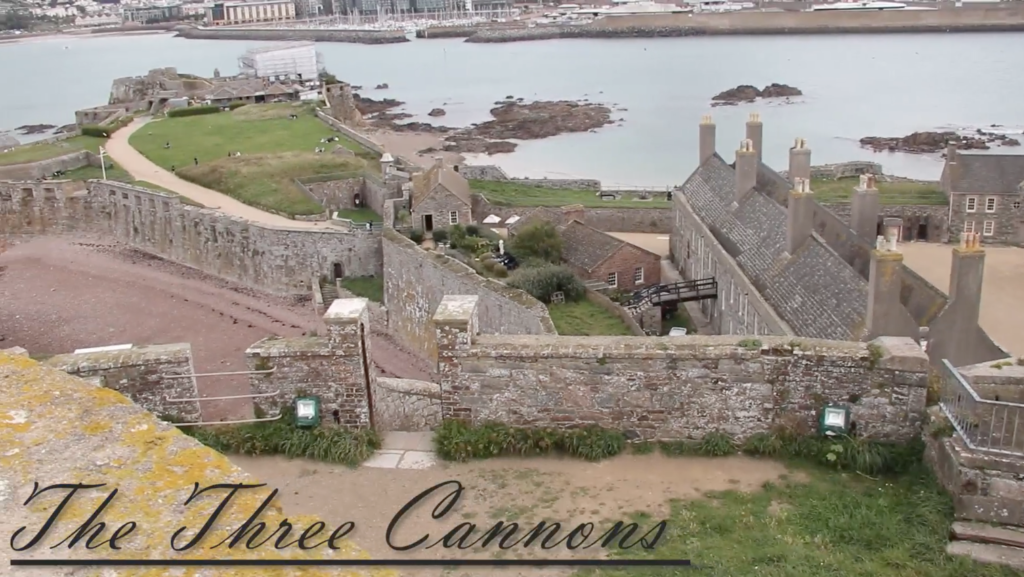

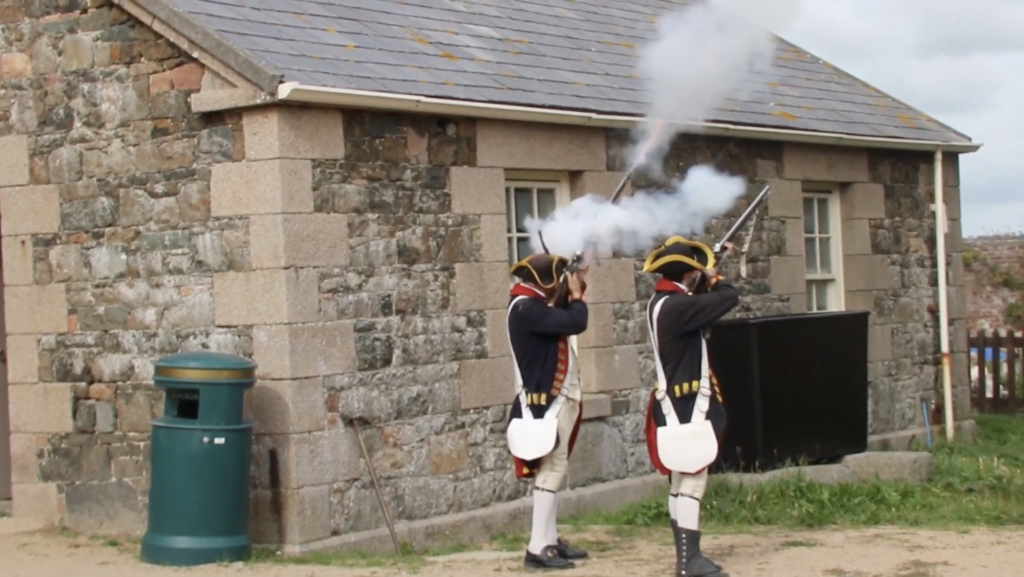

Link to Film: https: THE THREE CANNONS




We simply wanted our script for the film to be a series of voice overs that come from the perspective of a master gunner of the castle. He would talk about his everyday life, and express little anecdotes of things that happened while he was at the castle. It makes our film more of a documentary but using stories of the past that are filmed/recorded to add a bit more ‘life’ to the final outcome.
I am Master Gunner Jonathan Shipley, and I am garrisoned out at his majesty’s fortress, Elizabeth Castle.
Not much really happened out at the castle really, well not when I was out there. I moved to the garrison in 1785, so the French invasion four years earlier didn’t really affect me. I didn’t know anyone. I was training in England as a redcoat and then they saw that I could read and write, so they decided to give me a blue coat, double my pay and name me a gunner. But my favourite part is that everyone had to call me sergeant even though the only difference was that I had a new coat and hat.
I guess the typical day for me was wake up and get dressed, report to the parade ground for drill and then they send me to the Grand Battery, and I joined the crew for number 1 gun. I started off as just a vents man, holding my finger over the vent when it was being swabbed, then as the week progressed my role changed so that I knew every job that needed doing before we fired the gun. Doing the worming, the swabbing, the ramming, the priming and only once I had done all that, I was given a linstock.
Oh, what you saw there was me having to use my bayonet ‘cause I lost the linstock. I got 30 lashings for that, spent three days in bad with bandages on my back. I remember the sergeant got the cat ‘o’ nine tails out the bag and after about 10 lashings, the surgeon would come along with his bucket of sea water and throw it on my back, try and stop infection. I think I would’ve preferred the infection to be honest.
I know what you’re thinking, why has he got a musket. Yes, I mainly use the cannons but every man in the British Army got a musket for guard duty. I’d only carry nine rounds because that’s all that it was used for. If I see a sail on the horizon and I can’t tell if its English or otherwise, I would fire the musket into the air and the sound would warn everyone on the castle that there’s a ship – then everyone would get to their cannons, load and wait for orders. There was this one time, I had been moved to gun number 5 cause they had no one to aim the gun, and three or four ships sailed into the bay, and on the second or third volley, number 1 gun blew up killing 4 men and injuring about 8 others, I was a good 20 feet away and I still can’t hear anything out my left ear. I was on leave and just walked around the castle at low tide and the end of the barrel was just sticking out the sand.
I left the castle in 1805 and shipped off to Europe to fight against Napoleon. Returned in 1812 after I was blinded in one eye, I couldn’t easily move around at the speed I needed to on campaign, but the army kept me on and sent me back to the castle as an invalid to train the new recruits. I’m now the Master Gunner of the garrison – making sure everyone is safe, there’s enough food, the powders dry – all of that. I love my job. I’m one of the lucky ones that made it passed 25 and I will be here till the day I die.
As a group, we believe that the majority of the Castle’s history revolves around the Georgian era and the Battle of Jersey in 1781. From this, we came up with two ideas that we could use for our film.
From here we decided on the pros and cons of each idea when it would come to writing a script and planning a film shoot.

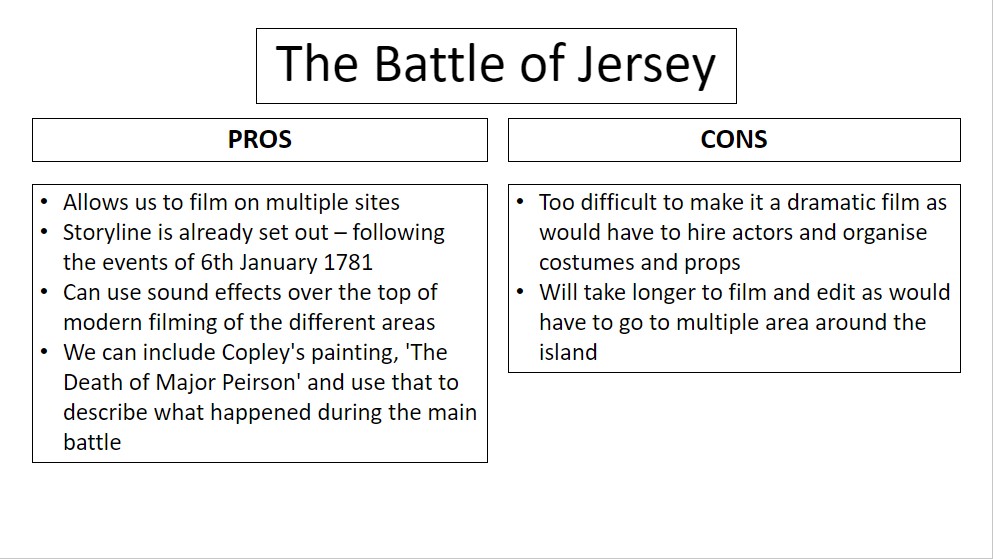
From these we decided that we want to create a documentary film following the day of the Battle of Jersey.
1- La Rocque, the place that the French landed in the early morning of 6th January 1781. The rocks that surrounded their ships and the channel that they took to reach the beach. Voice over of why the French decided to attack on January 6th in the first place.
2- The French entering the town from the East. Moving shot travelling down the roads that the French could have possibly taken, talk about the men that they murdered to ensure that they would keep the element of surprise.
3- French capture the Lieutenant Governor, Moyse Corbet. Shot of Capital House, perhaps use AI to create the look of the French force surrounding the building.
2- Elizabeth Castle, the view towards the island, how the castle defended itself from the French troops. Captain Mulcaster receiving and pocketing the surrender orders for the garrison then firing a single warning shot at the French contingent on the other side of the causeway.
3- South Hill (Fort Regent), the view from the flanking forces on top of mount Bingham. With the French in the market square, Peirson ordered some of the militia to position themselves on top of South Hill and fire down on the enemy.
4- Gallows Hill (West Mount), Major Peirson’s entry point into the Royal Square. The place that Peirson gathered his forces before marching onto the French (perhaps a shot of what can be seen from the top.
5- Market Square, the arena for the main battle (Royal Square). Audio of cannon and musket fire, video talking to the camera with details of what happened.
6- ‘The Death of Major Person’, the painting by Copley and the story by behind its characters. Voice over about Peirson’s death and where he was taken to die. The death of the Baron de Ruellecourt and how he was shot eight times. The story of Pompey, a black servant taken under the employ of Peirson while his master Captain Christie was on leave in Bath.
7- The legacy of the Battle, Musket Ball marks in the walls; the graves of Major Peirson and Baron de Ruellecourt; Mulcaster street. Voice over of how the island pays their respects today and how they commemorate the battle every year on the anniversary.
Link to more information about specific characters involved in the Battle.
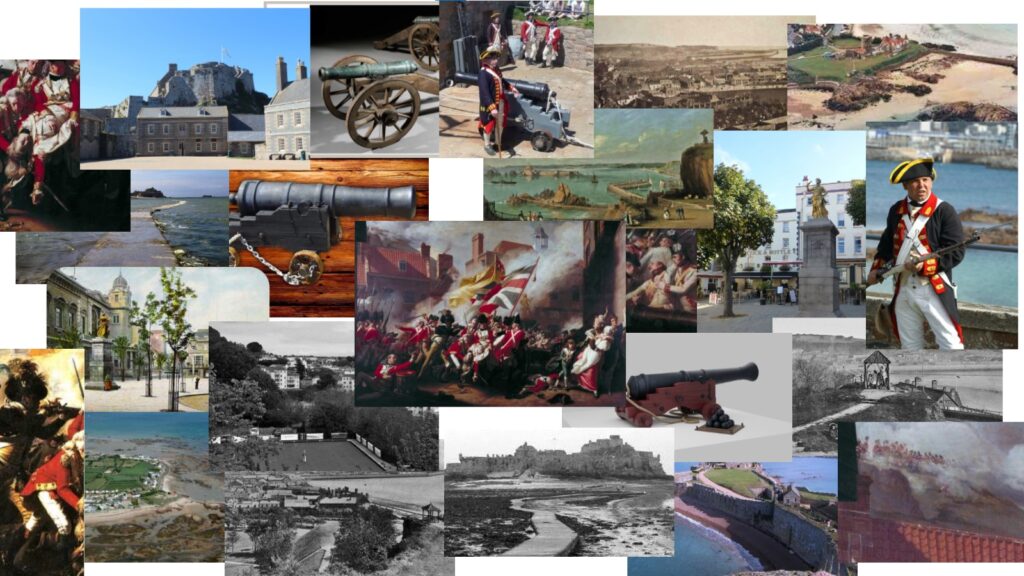
Gunners at Elizabeth Castle were known as invalids – men that were injured or too old to fight on campaign in the colonies. But as a gunner they have an extensive skill set that “Red Coat” infantry don’t have. Their knowledge and skill when firing cannon means that they can be put into a garrison and teach new recruits that could then join the colonial wars of the British Empire.
When you become a gunner, your wage doubles, you get a pension and three meals a day for the rest of your life. But your life expectancy drops significantly. It is the role of the Master Gunner (modern day Artillery Staff Sergeant) to train the new recruits to fight for their country and if needs be defend the castle from any potential invasion force.
Their uniform is royal blue, which is a more expensive dye and shows them as the elite in the British Army. A blue coat with red turn backs and gold lace clearly shows them as artillery men on the battlefield. Their buttons are unique and bear the insignia of the Royal Armouries – to the normal person it just shows them as gunners, but it serves as a reminder to the armouries of an embarrassing event that they have been forced to be reminded of always.

The insignia shows three cannons with three oversized cannon balls. This is not simply a nice design, it reminds the Armouries of the battle where they supplied cannon balls that were too big to fit down the barrels of the guns.
Although they are cannon men, they would deploy the musket when on guard duty. They would never carry more than nine rounds of ammunition and they only reason the musket will go off is if they see sails on the horizon. Instead of attempting to shout across the castle, they would fire the musket into the air to alert the entire garrison and call them to their duties. It was an early warning system.
In the event of an invasion force attacking the island, the gunners would man their cannons and employ the help of the infantry, at least one gunner per gun to aim and fire. The infantry would run the movements of worming, swabbing, loading and priming the cannon.
STEP 1: WORM THE CANNON
The first man holding the worm, a long pole with a double-cork-screw attached, approaches the cannon and puts the worm in. There is a black mark on the worm that should align with the end of the barrel if it is empty. If the line protrudes from the end of the cannon, stop the process and flood the gun. If it does not stick out, proceed to twist the worm clockwise and grip any paper left from the previous charge. Withdraw the worm while scraping the bottom of the barrel. Continue this process until no remnants get pulled out.
STEP 2: SWAB THE CANNON
The next man holding the swab, a wooden pole wrapped with dampened sheets fleece. The push and pull the swab in and out of the cannon repeatedly – this motion cools the cannon and extinguishes any burning embers left from the previous charge. However, the vent is unable to be swabbed as it is too small, and the swabbing action draws in air from outside the cannon. If there were any burning embers they would be continually resupplied with oxygen.
Therefore, we have another man as the vents man. His role is to place his finger over the vent to create a seal so that the swabbing action creates a vacuum within the barrel of the gun.
The swab is removed and the vents man removes his finger, the vent is then covered by a leather sleeve.
STEP 3: LOAD THE CANNON
A paper charge of gunpowder is brought from the magazine to the battery and placed in the end of the gun. The amount of gun powder is proportional to the weight of shot from the cannon; eg. if the shot weighs 6lbs, we need 2lbs of gunpowder. The charge is placed at the end of the barrel and a fourth man approaches the gun with the rammer, a long wooden pole. He rams the charge to the breech of the gun a compacts the charge as compression is what makes gunpowder explode.
The cannon ball would then be rolled into the barrel and pushed on top of the charge with some cloth to hold hold it in place and seal any gaps.
STEP 4: SET AND PRIME THE CANNON
The cannon is then pulled to its firing position by a pulley system of ropes.
Once in position the gunner will pierce the charge with a brass pin and fill the vent with thinner gunpowder known as priming powder. The gun is now ready to fire.
STEP 5: FIRE THE CANNON
As the flintlock mechanism was not yet installed on cannons, the gunner would use a linstock. This was a wooden stick with brass and copper fittings and rope treated with potassium-nitrate (saltpetre). This rope will now burn at a rate of 1 inch every 20 minutes without a flame ensuring a safe way of firing the cannon. It is known as slow match. The gunner would run to a nearby hurricane lantern to light the slow match and return to his position, and, when given the order touch the priming powder with the slow match to fire the gun. In accordance with Newton’s first law of physics, the force of the cannon ball being pushed out of the barrel of the gun would send the cannon backwards about 6ft.
The cannons were also very poorly cast when made and often had air bubbles inside them, meaning that at any point during the firing process the cannon could explode killing its gun crew.
The musket used in the 18th Century was known as the ‘Brown Bess’. A flintlock musket so named as it is a steel tube with a piece of flint on a lock – hence flintlock-musket.
STEP 1: HANDLE CARTRIDGE
First pull the flint back to what is known as the ‘half cock’. The lock is on a double ratchet mechanism so that when the hammer is pulled to half cock, the trigger will not work.
When in the battle lines, men a squashed tightly together so in order to get a cartridge from the cartridge box, they must draw a large circle with their arm to get to the box at the back of their person.
They take out a cartridge and bring to their mouth. As they have the musket held in their left hand and the cartridge in their right, the safest way of opening it is to use their teeth.
STEP 2: PRIME YOUR MUSKET
The gunner will bite the tab off the paper cartridge, spit it out and pour about one gram of gunpowder into the priming pan. Immediately close the pan cover (frizzen) to prevent the priming to be blown away or lost for any reason.
STEP 3: LOAD YOUR MUSKET
Invert the musket so that the muzzle is at the top and the lock is facing outwards. Empty the cartridge into the musket and push the paper in as well. The musket ball would be tied in on the end of the cartridge and the paper provides wadding and adds compression. It also prevents the musket ball from rolling out of the barrel.
STEP 4: RAM YOUR MUSKET
You then deploy the ramrod from under the musket and throw it down the barrel. Use it to hit the cartridge at least three times which is more than enough compression to put the musket ball through a solid oak door that’s five inches thick from about 100 yards. Remove the ramrod and place back under the musket. You are now loaded and ready to fire.
STEP 5: FIRE
Hold up the musket to the poised position and pull the hammer to the fully cocked position.
Take aim.
FIRE – pull the trigger and hope it works
A musket will fail at rate of 30% and this could be for an range of reasons. The frizzen could be too shallow, or it might not spring out of the way fast enough. The hammer could be moving to slow. The powder could be wet or it could have been blown away.
The garrison worked on a hot bed system, three men to a bed. One will be resting while another is on guard duty and a third is training. They will rotate so that they have 8 hours doing something every 24 hours, there will always be men guarding the walls. In the main barracks, there would be 300 men living in that building whereas the officers’ barracks housed 12 officers minus the captain who stayed in the Captain’s House.
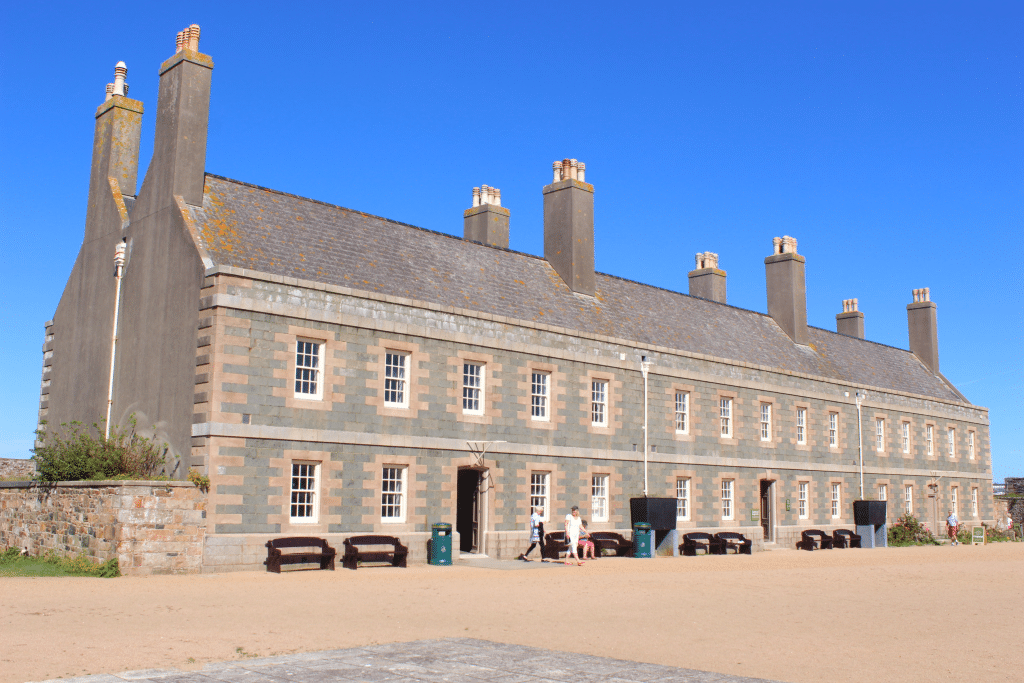

A gunner would wake up and do drill for six hours at least every day, clean his musket to ensure it is always functional in any weather condition, practice firing the cannon and aiming at rocks out in the sea. The British were the only European army that could train with live ammunition so when it comes fighting they would have the better accuracy on the field. The gunner would then spend eight hours on guard duty before returning to his bed which would still be warm from the previous man, hence the term ‘hot bed’. Soldiers would often sleep with their muskets so they would always be ready to defend the island, and also have the knowledge that no one will have tampered with it.
Elizabeth Castle’s history spans across 1500 years from the death of St Helier in 555 AD to the Nazi Occupation of 1940-1945.
Mont Orgeuil (Gorey Castle) was now made obsolete with the invention of gunpowder warfare, especially as invading forces could easily position there guns on the Mont St Nicolas and easily destroy the castles walls. Building began in 1550 under Edward VI – the first Castle on the Mound.
Under Elizabeth I, construction was finished and the Castle was built larger than what it was planned to be after the threat of a second Spanish Armada after 1588. With a stronger castle, Elizabeth could launch ships from St Aubin’s Bay, one of the largest deep water bays in Europe, to stop the Spanish before they enter the English Channel. From then onwards, Elizabeth Castle became the primary defence centre for the island.
The queen initially named the fortress the ‘New Castle’ but with Sir Walter Raleigh as Governor of the island between 1600 and 1603, he renamed it as Elizabeth Castle to regain favour with the Queen, however, we do not know if this was intended to flatter Elizabeth I or his mistress of the time, her Lady in Waiting who was also named Elizabeth.
The strategic positioning of Elizabeth Castle meant that it could easily defend St Aubin’s Bay, one of the largest deep water bays in Europe as any cannon on the castle, being higher than sea level, could easily fire down on enemy ships. This not only gave the garrison a larger firing range but it also provided an easy defensive position as ships at sea level would find it very difficult to get close enough to even attempt a shot at the castle walls.
By the beginning of the Stuart era, The castle walls extended to where the Café is now with a monastery built in the parade ground. The Castle was one of the last Cavalier strongholds held against the Parliamentarian forces in the English Civil War. Jersey was loyal to the monarchy so when King Charles II was exiled (then the Prince of Wales) he was given sanctuary at Elizabeth Castle where he stayed in the Governor’s House with his brother in 1646. He later returned after the execution of his father with an entourage of 300 men in 1949 where he was proclaimed King for the first time by the people of Jersey. During his stay, Charles II pointed out the weakness of having an unprotected piece of land directly adjacent to the castle walls even with a natural sea moat, and he invested 3,000 pounds in the construction of the outer ward.
Once he had fled to France the Parliamentarian’s had taken the rest of the island with the help of Guernsey Militiamen and laid siege to the Castle. The Cavalier’s had enough supplies of food, fresh water and gunpowder to last for a further 18 months, but they made a fateful mistake. They stored all of the resources in the crypt of the Monastery that was where the Parade Ground is now. The Parliamentarian’s positioned siege mortars on South Hill (today Mount Bingham). Within their first bombardment of the castle, a mortar fell through the roof of the monastery, through the floors and into the garrison’s supply of gunpowder. The explosion that ensued destroyed all of the buildings of in the parade ground bar 1, the gate house which is now used the Castle’s café.
The Parade Ground was rebuilt during the Georgian era to how it is seen today with an Officer’s Barracks that housed 12 officers; an Infantry Barracks that housed 300 men with 6 wives of the Garrison staying the attic; a canteen at the North end; the Ordinance Store at the South; and the Gym, Library and Fire Station next to the Ordinance Store.
By the Battle of Jersey in 1781, the castle was armed with more 50 24lb Guns with a range that could easily cover the bay of St Aubin.
Storyline of the Battle of Jersey – 1781:
The French fleet under the command of the Baron de Ruellecourt, left the coast of France at 2300 hours on the 5th January arriving at La Roque at roughly 0500 hours on the morning of the 6th.
Their initial army included about 900 infantry plus 200 cavalry and 50 pieces of Artillery. With the help of Pierre Journeaux, a traitor that fled to France after being accused of murder, he guided the French shipping through the narrow channel in between the rocks at La Roque. The ships had to travel in single file and to avoid being spotted by Jersey Militiamen guarding the coast, they only had a single lantern lit behind each vessel. It is believed that one lantern must have been blown out and the following ships that contained all of the French artillery and cavalry strayed onto the rocks, 200 men drowned. Despite this, the French army continued to the Market Square (now the Royal Square) with 700 men arriving at about 0600 hours. They immediately secured the Court House.
Alerted by the noise of the French troops, people came to their doors to see what was happening. Jean De Ste Croix was bayoneted and struck on the head by a sword but managed to escape to a neighbour’s house. One of the sentries in the Piquet House near the Square in Church Street was killed but the other managed to escape and ran to the Hospital, which was being used as a barracks for the British troops of the 78th Regiment, and raised the alarm. By 7am, Lieutenant Governor Moyse Corbet, still in his nightshirt, was captured. Dressing hurriedly, he was escorted to the Court House where he was met by de Rullecourt, who demanded that Corbet sign articles of surrender. British regiments and the Jersey Militia began to gather across the Island in response to messages and alarm guns being fired.
To ensure the success of his occupation, de Rullecourt needed to neutralise Elizabeth Castle and get the garrison there to surrender. He sent a demand for surrender which was pocketed by Captain Mulcaster. His attack on the Castle was repulsed by a single warning shot fired from the Gate Battery, killing two men and removing the leg of a French officer, forcing French forces to retreat. A second party of French officers demanded the surrender of the Castle and again this was refused. By now it was 10.45am and the incoming tide was covering the causeway. With French forces at the opposite end, Mulcaster could only send a few troops across to aid the main contingent in the Battle, the rest were stranded at the castle.
Major Francis Peirson, the leader of the British forces, began positioning his troops on Gallows Hill (Westmount). He sent soldiers to South Hill so they could fire onto the Square from above and he gave the order to march on Town.
French forces took three militia cannon from the Town Church and placed them in the entrances to the Square. The two placed by the Town Guard House were pointed straight down into La Grande Rue (Broad Street) in the direction of the advancing British troops. Inexperienced French gunners set them too high and when the first was fired at 40 metres, the shot sailed harmlessly over the advancing troops. Seeing this, the men tending the second cannon panicked and fled, abandoning both cannon. At the same time, the fire from troops on South Hill was so intense that many French troops took shelter in the houses surrounding the Square.
Meanwhile, Peirson led his men into the Square. Realising that they were in danger of being caught in the line of fire, he was motioning his men back when he was struck by a bullet. His men dragged him to the safety of Mrs Fiott’s house nearby (now a shop on the corner of the Square) where he died. He was only 24 years old.
Finding themselves attacked from all sides, the French began to waver. De Rullecourt emerged from the Court House with Lieutenant Governor Corbet at his side, possibly with the intention of surrendering, when he was struck by musket balls fired by the 78th Highlanders. Two balls passed through his thigh, a third went through his neck and a fourth shattered his jaw. The French invasion was over. Miraculously, Corbet, despite having his hat shot away, survived unscathed. De Rullecourt was carried over to Dr Lerrier’s House on the east side of the Square where he died six hours later.
With Peirson dead, Corbet resumed command of the British forces in the Island as French prisoners were rounded up. The rank and file were held in the Town Church and the Officers were held in the Royal Court House. Corbet was later court-martialled and found guilty of surrendering.
The overall numbers included:
After the battle it was decided to build Fort Regent and make that the Primary Defence centre of the island as Elizabeth Castle was proven to be useless if their was an attack from elsewhere in the island.
That was the last invasion until the Nazi Occupation during the Second World War. The fast moving War Machine of the Nazi’s meant that there was a steady supply of Russian and Polish slave workers being shipped into the islands wher they were put to work to fortify the Channel islands as part of Rommel’s Atlantic Wall. Two artillery bunkers were built on the EAst and West sides of the Castle with guns powerful enough to hit Gorey and Corbier on their respective sides. A Fire Control Tower was built at the very of the castle with multiple Anti-Aircraft positions situated around it to protect the castle. An Anti-Tank Gun is positioned at the gate Battery to protect from attack from the island and if needed could be used to hit the town. A searchlight on rail-tracks could be wheeled out of its protective bunker under the Georgian Hospital to a position that could patrol the harbour. 100 Nazi Soldiers lived out at the castle and nothing has been changed at the castle until today. The majority of the bunkers are open to the public, with the guns being the originals and were never removed from their positions.